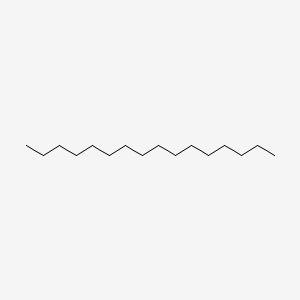| MeSH term | MeSH ID | Detail |
|---|---|---|
| Lupus Erythematosus, Systemic | D008180 | 43 associated lipids |
| Body Weight | D001835 | 333 associated lipids |
| Coronary Disease | D003327 | 70 associated lipids |
| Peritonitis | D010538 | 38 associated lipids |
| Hyperplasia | D006965 | 34 associated lipids |
| Glomerulonephritis | D005921 | 35 associated lipids |
| Encephalomyelitis, Autoimmune, Experimental | D004681 | 26 associated lipids |
| Keratosis | D007642 | 9 associated lipids |
| Serratia Infections | D016868 | 2 associated lipids |
Hexadecane
Hexadecane is a lipid of Fatty Acyls (FA) class. The involved functions are known as Analyte. The related lipids are Fatty Acids and palmitoleic acid.
Cross Reference
Introduction
To understand associated biological information of Hexadecane, we collected biological information of abnormalities, associated pathways, cellular/molecular locations, biological functions, related genes/proteins, lipids and common seen animal/experimental models with organized paragraphs from literatures.
What diseases are associated with Hexadecane?
There are no associated biomedical information in the current reference collection.
Possible diseases from mapped MeSH terms on references
We collected disease MeSH terms mapped to the references associated with Hexadecane
PubChem Associated disorders and diseases
What pathways are associated with Hexadecane
There are no associated biomedical information in the current reference collection.
PubChem Biomolecular Interactions and Pathways
Link to PubChem Biomolecular Interactions and PathwaysWhat cellular locations are associated with Hexadecane?
There are no associated biomedical information in the current reference collection.
What functions are associated with Hexadecane?
Related references are published most in these journals:
| Function | Cross reference | Weighted score | Related literatures |
|---|
What lipids are associated with Hexadecane?
Related references are published most in these journals:
| Lipid concept | Cross reference | Weighted score | Related literatures |
|---|
What genes are associated with Hexadecane?
There are no associated biomedical information in the current reference collection.
What common seen animal models are associated with Hexadecane?
There are no associated biomedical information in the current reference collection.
NCBI Entrez Crosslinks
All references with Hexadecane
Download all related citations| Authors | Title | Published | Journal | PubMed Link |
|---|---|---|---|---|
| Saikia RR and Deka S | Removal of hydrocarbon from refinery tank bottom sludge employing microbial culture. | 2013 | Environ Sci Pollut Res Int | pmid:23764986 |
| Masheder B et al. | Transparent and hard zirconia-based hybrid coatings with excellent dynamic/thermoresponsive oleophobicity, thermal durability, and hydrolytic stability. | 2013 | ACS Appl Mater Interfaces | pmid:23848181 |
| Park HB et al. | One shot-two pathogens blocked: exposure of Arabidopsis to hexadecane, a long chain volatile organic compound, confers induced resistance against both Pectobacterium carotovorum and Pseudomonas syringae. | 2013 | Plant Signal Behav | pmid:23603940 |
| Cheng L et al. | Novel bacterial groups dominate in a thermophilic methanogenic hexadecane-degrading consortium. | 2013 | FEMS Microbiol. Ecol. | pmid:23621116 |
| Naether DJ et al. | Adaptation of the hydrocarbonoclastic bacterium Alcanivorax borkumensis SK2 to alkanes and toxic organic compounds: a physiological and transcriptomic approach. | 2013 | Appl. Environ. Microbiol. | pmid:23645199 |
| Longo PL et al. | Gene expression and phenotypic traits of Aggregatibacter actinomycetemcomitans in response to environmental changes. | 2013 | J. Periodont. Res. | pmid:23600969 |
| Bequer Urbano S et al. | Lipid storage in high-altitude Andean Lakes extremophiles and its mobilization under stress conditions in Rhodococcus sp. A5, a UV-resistant actinobacterium. | 2013 | Extremophiles | pmid:23283521 |
| Rafin C et al. | Exploring micromycetes biodiversity for screening benzo[a]pyrene degrading potential. | 2013 | Environ Sci Pollut Res Int | pmid:23093417 |
| Cheng L et al. | Enrichment and dynamics of novel syntrophs in a methanogenic hexadecane-degrading culture from a Chinese oilfield. | 2013 | FEMS Microbiol. Ecol. | pmid:23066709 |
| Pęziak D et al. | Bioavailability of hydrocarbons to bacterial consortia during Triton X-100 mediated biodegradation in aqueous media. | 2013 | Acta Biochim. Pol. | pmid:24432333 |
